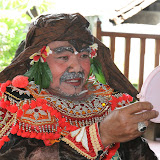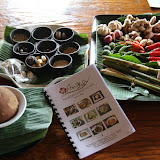See also Part 1 and “Photo Gallery - Just another day in Ubud?”
(Continued from Part 1)
 We had spotted the large black bull on our first day in Ubud. It was now joined by a large tower (“bade”) richly decorated in gold and bearing the portrait of the man to be cremated.
We had spotted the large black bull on our first day in Ubud. It was now joined by a large tower (“bade”) richly decorated in gold and bearing the portrait of the man to be cremated. Here "size counts", and the size of the bull and tower indicates that this was provided by a wealthy family (although this would put a dent in their fortunes).
Participants and spectators alike filled the narrow street, providing a potential market for vendors selling drinks, snacks, sarongs and sashes. A local man offered guided cremation tours with expert commentary. In Bali things don’t happen until the “right time” although what is “right” may not be apparent to outsiders, so eventually gongs rang out, offerings were made, and the many men in matching polo-shirts took their places in the large bamboo frame on which the bull and tower rested. There were chants and cheers; the band struck up a tune; the men took the weight of the structures, and with great excitement the procession set off.
They only moved a short distance before the horns of the bull snagged power and phone lines which had not been pushed up quite high enough by the men with the long bamboo poles. Wires were raised and they were off again, only to stop again a little further on. After a few false starts the wires were eventually cleared and the bull set off down the street. The porters shook the bull, as if to toss off the rider clasping the bull’s neck. This was to symbolise the difficult passage of the soul to the next life. At the street corners the structure was turned so that the spirit would be confused and unable to make its way back to the starting point.
 |
| Who needs power lines anyway? |
As we ate lunch we heard music and shouting. Men with poles were propping up the power lines again – most of the phone lines had already been pulled down. Along came another bull and tower, with attendant crowd. Although the style was similar, this was not the “deluxe” version of the earlier event, but a more modest occasion. We watched with interest until the procession had disappeared down the street then returned to our lunch.
 |
| Not such a happy day for this piglet |
 |
| Porters halt as their tower goes under lines not pulled down by the earlier procession. |
 |
| Our "cottage" (lower right half of the building on the left and the inviting pool. |
Casa Luna has a very good continental bakery, so we enjoyed coffee and tarts to the sounds of an excellent 4 piece jazz band with an outstanding trumpeter. The rain grew even heavier and water entered through the open sides of the café forcing the keyboard player and sound mixer to rig up plastic shelters to protect the electronics. After an hour there was no sign of the rain easing so we waded through the water to get into a taxi to take us home. The steep stretch of road at the start of our street looked like a series of rapids and the driver could hardly see through the rain along the unlit road, but after an interesting ride and quick sprint along the path between the padi fields we made it home.
We went to sleep to the sound of frogs and the pouring rain after an interesting day, just another day in Ubud.

























